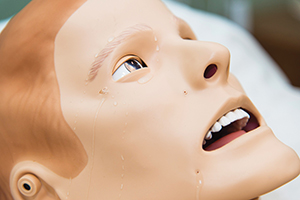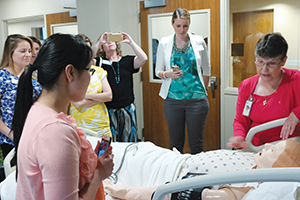By ELLEN FUTTERMAN
They can blink, cry, breathe, turn blue, even talk. Dozens of medical procedures can be performed on them to mimic a variety of medical scenarios including a complicated birth, critical changes in vital signs, pupil dilation, and traumatic injuries including broken bones and burns.

A medical manikin equipped to cry and produce secretions from his mouth and nose.
Medical manikins have long been a staple of medical and nursing school training. Now these lifelike, pretend patients are being used to hone the knowledge, skills and responses of new hospital employees and seasoned clinicians too. Since opening in March 2015, the Simulation Center at CHRISTUS Santa Rosa Health System has trained more than 250 nurses and other health professionals in both basic and advanced procedures.
Located at the Children's Hospital of San Antonio, the Simulation Center was made possible by a $1.6 million grant from CHRISTUS Health. It is the largest training center of its kind in Texas located in a private hospital.
Catholic Health World spoke to Gayle Dasher, director of clinical practice at CHRISTUS Santa Rosa Health System, to find out more about the Simulation Center.
How common are these simulators?
Over the last 10 years, the simulators have become common, particularly in formal nursing education programs. Most nursing schools and larger universities have simulation centers. They are now becoming more prevalent in hospitals that are unaffiliated with universities, and that is what CHRISTUS Health has been trying to accomplish — the placement of these simulation centers in our community hospitals.
What kind of simulators do you have?
We have eight simulators of varying fidelities. Our adult simulators, called 3-G Man, are the highest fidelity. Fidelity describes the capability of the manikin to interface with computer programming, which actually drives what you see with the manikin. These adult manikins can simulate everything from seizure activity to (cardiac) arrest episodes.
We have a birthing manikin that delivers a baby either breech or normally. We have a baby manikin that simulates the brand new newborn. In our other pediatric rooms we have Sim Junior and Sim Baby manikins that can simulate anything from an arrest episode to a postoperative or a medical diagnostic. You can go very high level with a number of these manikins.
What is the main goal in using a simulator?
The ultimate goal is to enhance patient safety. With simulation you can provide clinicians with an environment in which it's OK to learn, it's OK to take your time and it's OK to see what happens if you make the wrong decision. I tell our nurses if you're going to make a mistake, make it here and use it as an opportunity to learn.
The secondary goal is to improve the competency of your clinical staff — to make them more comfortable with new equipment, new procedures or, in the case of new graduates, to help them build their bank of critical thinking experiences.
Are these simulators for seasoned professionals, or just newly minted clinicians?
We use them for the full gamut of all of our associates, from new graduates to our most experienced staff.
What does a simulator do?
I'll use the example of 3-G Man. You can listen to heart sounds, lung sounds; his eyes open and close; he breathes so his chest rises and falls; his pupils constrict and dilate; he has palpable pulses; you can fill a reserve with fluid and he will tear; he can have secretions from mouth and nose; he can urinate; he can do a wide variety of things. We can make him have a seizure. You can simulate virtually any kind of condition you want. Because he interacts and interfaces with the computer, we can simulate his physiological response to be appropriate with whatever intervention we choose. I dare say you can simulate virtually any kind of clinical situation you would desire.
Is medical simulation training modeled after military and commercial airline safety simulation?
Yes. It's certainly based on the principle of crew resource management where you identify the essential elements for safe care, then ensure staff can identify and address each of those essential elements just as they would at the bedside.
What about the surroundings where the simulators are used? Do they mimic what the actual hospital units look like?
They do. Our simulation center was built on a former nursing unit and so the rooms are set up to look exactly like a patient room. If we're simulating something in the ICU, we will set up the room exactly like one of the ICU rooms. If we're doing labor and delivery, that room is set up just as it would be in a real labor and delivery. Things are in the same place so staff can act the same way in the simulation room as in a real patient room.
How much of the software is prepackaged and how much can you create?
There are scenarios that have already been created that are available for purchase. It's a little like going to the iTunes store for simulation. You go visit the Sim Store and search for a particular simulation to meet your needs. But with some expertise from your simulation technician like we have at CHRISTUS, we can develop a simulation from scratch. You can customize the simulation the way you want. It not only can save you money, but it also allows you to simulate situations appropriate to your particular population or your particular facility.

Gayle Dasher, right, director of clinical practice at CHRISTUS Santa Rosa Health System, tells a group of "moms with blogs" how high-fidelity patient simulators are used for teaching in the hospital. The hospital hosts quarterly luncheons with the bloggers, whose posts are read by parents in the community.
Do these patient simulators break down frequently?
We've been fortunate in the months we've been open to not have had one break-down. Some of it is basic troubleshooting.
I anticipate as we get more wear and tear on the manikins there will be times when they need to be sent in for repairs.
What is the cost of these manikins?
The lower fidelity manikins run $20,000 to $25,000. The highest fidelity 3-G manikins run between $60,000 and $70,000.
How authentic is the experience?
I think the staff would tell you these simulation experiences are very authentic. It takes them a few minutes to get over the idea that they are dealing with a manikin. Once they get into the scenario and start seeing the manikin respond the way a person would respond they begin to suspend reality.
And the manikins can talk, how does that work?
There is a set vocabulary already programmed into the scenarios so the manikin could respond with a particular statement at a specific time during the simulation. We also speak for the manikin. As we observe the simulation we put headsets on from the control room. We can follow the actions of the staff because each room is equipped with two cameras and a microphone. We can see and hear our clinical staff in the room interacting with the manikin. So we tell them (to) talk to the manikin like a real patient. As they interact with the manikin we can speak and answer their questions and the voice comes through the manikin. It's a little creepy, but it makes it very real.
How does simulation complement traditional training?
With traditional training you do a lot more teaching with PowerPoint presentations. With simulators you can build on what they know and give them true hands-on experience.
How do these simulators fit into the mission of CHRISTUS health care?
Our mission is to extend the healing ministry of Jesus Christ, and these simulators allow our staff to put that into action. I call simulation the opportunity to use their training wheels, to begin to hone their skills. It's the chance for them to practice their interpersonal interactions as well as to improve the care they provide to our patients. After these experiences in our Simulation Center, our associates have the best preparation possible to extend the healing ministry of Jesus Christ to all those who come to us for care.